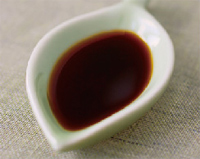Here is the article.
_ _ _ _ _ _ _ _ _ _ _ _ _ _ _ _ _ _ _ _ _ _ _ _ _ _ _ _ _ _ _ _ _ _ _ _ _ _
(Start quote)
![]()
“Umami,” which appears in the presence of other foods, represents the “Fifth Taste” essential to Japanese cuisine.
Umami is one of the five tastes in Japanese cuisine and is said to be the fifth taste after sweetness, sourness, saltiness and bitterness. Fermented foods like cheese and vegetables like tomatoes contain high levels of umami. In Japanese cuisine, using the umami contained in seafood, seaweeds, mushrooms and fermented foods extracts the natural flavor of the respective ingredients and provides an excellent seasoning even in foods with low fat content. Umami represents the cornerstone of healthy Japanese food.

Yuzu pepper used in a French sauce.
A variety of ingredients containing Japanese “umami.”
To use the umami element in Japanese cooking, water and dashi ingredients must be used to obtain dashi stock. Mostly dried ingredients are used to make dashi stock. The umami elements increase during the drying and processing stages and nutrients are also concentrated. Miso paste or fermented soybean paste and soy sauce, both essential ingredients in Japanese cooking, also gain added umami during processing. It is well known that sushi and sashimi is eaten with soy sauce as the umami of soy sauce enhances the flavor of fish with minimal salt. Japan is blessed with a wealth of umami food ingredients that extract the natural taste of the raw ingredients.

“Katsuo bushi,” dried and fermented bonito flakes.

“Miso,” fermented paste made from soybeans and usually rice or barley.

Soy sauce, made from soybeans,wheat, and salt by fermentation for several months.
Secrets behind the flavor of dashi stock ? its constituents.
The constituents of dashi stock include inosinic acid and glutaminic acid, types of amino acids. It is known that these produce a stronger umami effect when used in combination. Just as meat flavor improves when simmered together with vegetables, savoring Japanese dashi stock in conjunction with food ingredients creates a masterpiece of flavor.

A salad enjoyed with a sauce made of miso.
Using favorite Japanese seasonings in world cuisine. Unusual combinations are delicious.
An increasing number of chefs around the world are using distinctive Japanese seasonings like soy sauce, miso paste and yuzu pepper. The unique aroma and sensory stimulation of these ingredients are popular among diners. They make ideal seasonings for vegetable dip, pasta sauces and stir-fried vegetables and enable diners to discover completely new flavors.
(Unquote)
Above was cited from Ministry of Agriculture, Forestry and Fisheries.
http://www.maff.go.jp/e/foj/food/umami.html
_ _ _ _ _ _ _ _ _ _ _ _ _ _ _ _ _ _ _ _ _ _ _ _ _ _ _ _ _ _ _ _ _ _ _ _ _ _
Please try!
